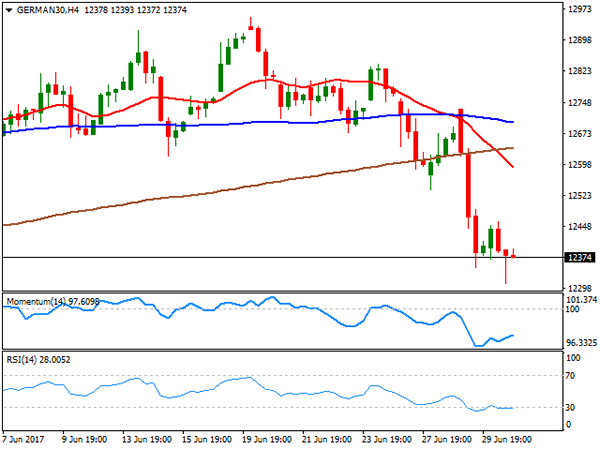EUR/USD
The EUR/USD pair closed the week at 1.1426, retreating modestly on Friday after setting a weekly high at 1.1445, amid prospects that several major central banks will join the Fed in the tightening path. The common currency found further support on Friday on local macroeconomic data, as German Retail Sales rose by more than expected in May, up by 0.5% in the month, and by 4.8% when compared to a year earlier, whilst European inflation advanced in June according to preliminary estimates, up 1.3% yearly basis, beating expectations of 1.2%. Core inflation rose 1.2%, also above market’s forecast of 1.0%. In the US, the PCE index declined 0.1% for May following a 0.2% gain in April, whilst core PCE rose 0.1%, in line with market’s expectations, although the year-on-year rate advanced 1.4%, from previous 1.5%, weighing on the greenback, as despite hawkish policy makers, soft inflation will delay tightening measures in the country.
During the weekend, German’s Bundesbank Jens Weidmann, also a member of the ECB, said that the Central Bank is working on moving away from its easing monetary policy, which may add fuel to the fire, and trigger further EUR gains ahead. At the beginning of the week, the EU will see the release of the final revisions of June Markit PMIs, while later on the week, the ECB will release the minutes of its latest meeting. In the US, attention will focus on employment, with the Nonfarm Payroll report to close the week.
Technically, the pair is quite close to a major long-term resistance, the 1.1460 region that contained advances pretty much since January 2015, which may indicate some corrections ahead, although a break beyond it should favor additional advances towards 1.1615, May 2016 high first, and later towards 1.1713, August 2017 high. Indicators in the daily chart have reached overbought territory, rather a consequence of the sharp rally seen last Tuesday and after five weeks of consolidation than a sign of upward exhaustion. Indicators are barely retreating, but the price is well above all of its moving averages, maintaining the risk towards the upside. Shorter term, and according to the 4 hours chart, the upside is also favored, as the price holds well above a bullish 20 SMA, whilst the Momentum indicator corrected from extreme overbought levels but settled above its 100 level, while the RSI indicator retreated partially, but bounced from the 70 level, in line with further gains ahead.
Support levels: 1.1380 1.1345 1.1300
Resistance levels: 1.1460 1.1495 1.1530
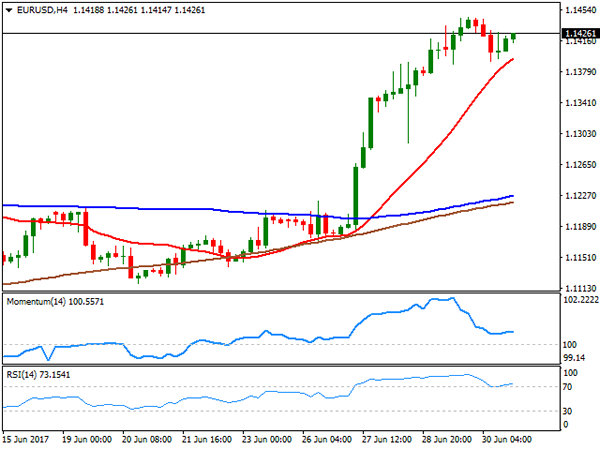
USD/JPY
The USD/JPY pair closed with gains for a third consecutive week, despite broad dollar’s weakness, finding support in surging US Treasury yields. Early Friday, Japan released its May inflation, with core CPI up 0.4% when compared to a year yearly, increasing for a fifth consecutive month, but still vastly below BOJ’s 2% target, limiting possibilities of tapering in the Asian country. In the US, yields advanced for a fourth consecutive session, with a notable advance in shorter-term ones, as the 2-year note benchmark advanced 0.62% to 1.385%, while the 10-year note yield ended the week at 2.30%. Despite the immediate effect over the pair was positive, the US yield-curve kept flattening, reflecting investors’ concerns over lagging US inflation, which long term, is dollar’s negative. From a technical point of view, the daily chart for the pair maintains a bullish bias, as technical indicators advance above previous highs and near overbought levels, although the price was unable to settle above a bullish 200 SMA, currently at 112.60. A stronger resistance comes at 112.90, where the pair topped for the week and the 23.6% retracement of its latest bullish run. In the 4 hours chart, the 100 SMA has crossed above the 200 SMA, both in the 111.000 region, while technical indicators turned lower within positive territory, suggesting the pair may need to surpass the mentioned high to gain enough upward strength to extend its advance this Monday.
Support levels: 112.00 111.60 111.20
Resistance levels: 112.50 112.90 113.30
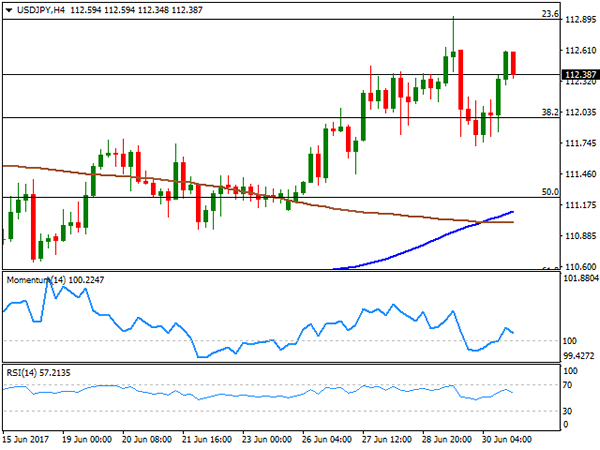
GBP/USD
The GBP/USD pair closed the week with strong gains, settling at 1.3025, its highest since mid May, backed by dollar’s weakness and the surprise change in BOE’s Carney stance towards monetary policy. Two weeks after saying that rate raises were not on the table yet, Carney said that hikes may be "necessary" should the economy and wages recovery. Pound’s recovery was also supported by the fact that PM May has finally managed to form a government, with no fresh Brexit headlines last week denting investors’ sentiment. On Friday, the UK released its final revision of Q1 GDP, unchanged at 0.2% for the quarter. On Monday, attention will center on the Markit Manufacturing PMI for June. In the meantime, the daily chart for the picture shows that technical indicators pared gains amid an intraday correction on Friday, but remain near overbought levels, whilst the 20 DMA is barely gaining upward strength far below the current level. In the 4 hours chart, the Momentum indicator eased within positive territory, but the RSI indicator bounced after correcting to 70, maintaining its bullish slope, while the 20 SMA continues heading north below the current level, maintaining the risk towards the upside. Still, the pair has a major resistance in the 1.3040/50 region, where rallies were contained last May, and would need to clearly break above it to continue advancing.
Support levels: 1.2990 1.2965 1.2920
Resistance levels: 1.3045 1.3090 1.3130
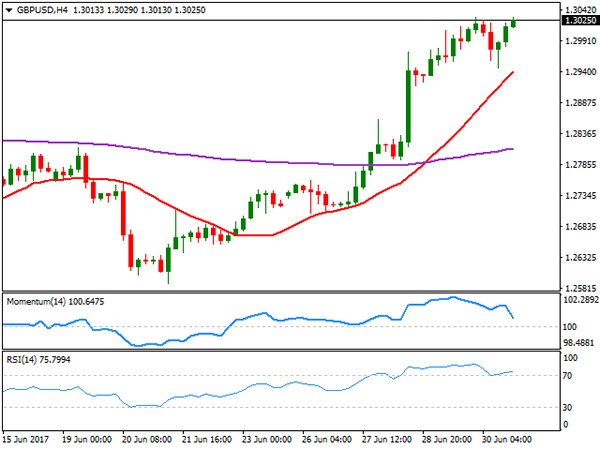
GOLD
Gold prices closed the week in the red, with spot ending at $1,241.27 its lowest settlement in six weeks, undermined by gains in bold yields worldwide. The safe-haven metal came under selling pressure amid a shift in monetary policies’ stances among central bankers, with rising speculation that most G10 banks are considering scaling back their monetary easing programs. Sluggish physical demand in Asia also weighed on the precious metal. The bearish stance is clear in the daily chart, as the price was contained by selling interest around the 100 DMA, while the 20 DMA accelerated its slide and is about to cross the longer one towards the downside. Technical indicators in the same time frame head lower within bearish territory, with the RSI indicator now at 39, anticipating some further slides ahead, moreover on a break below 1,236.48, the weekly low. In the 4 hours chart, the price develops below bearish moving averages, whilst technical indicators have pared their declines, but remain around their weekly lows, also in line with another leg lower ahead.
Support levels: 1,236.45 1,229.35 1,220.80
Resistance levels: 1,257.20 1,265.10 1,273.80
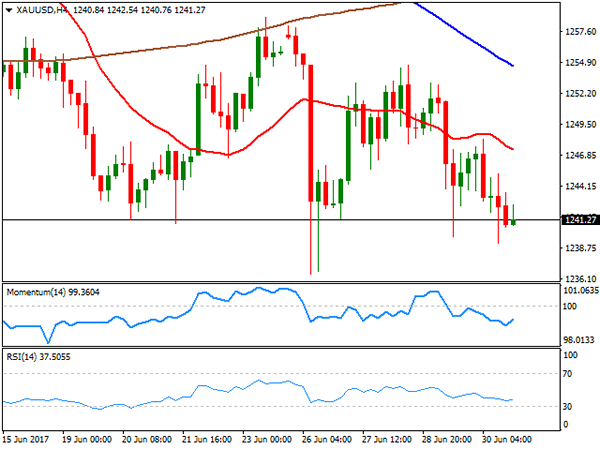
WTI CRUDE OIL
Crude oil prices continued advancing on Friday, closing at their highest in over two weeks, helped by signs of easing output in the US, as the Baker Hughes report showed that the number of active oil rigs fell by 2 last week, the first decline in January. The news added to the EIA report released mid-week, which showed that US crude output dropped 100,000 barrels per day in the week ended June 23rd. West Texas Intermediate crude oil prices ended the week at $46.32 a barrel, heading into the weekly opening with a bullish stance, as the price extended beyond the 38.2% retracement of its June slump, a 45.80, now the immediate support, whilst technical indicators head strongly higher above their mid-lines, as the price broke above its 20 SMA for the first time in almost a month. Shorter term, the 4 hours chart technical indicators have lost upward strength but remain within overbought readings, whilst the 20 SMA crossed above the 100 SMA below the current level, reflecting the ongoing upward strength and supporting some further advances on a break above 47.00, the 50% retracement of the mentioned decline and the immediate resistance.
Support levels: 45.80 45.20 46.60
Resistance levels: 47.00 47.60 48.10
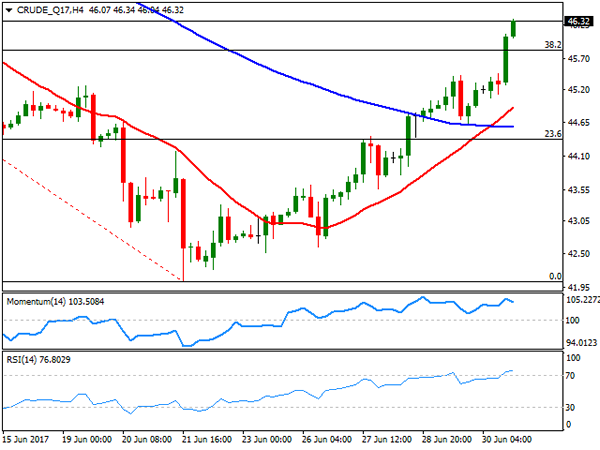
DJIA
Wall Street closed mixed on Friday, with the Nasdaq Composite down 4 points to 6.140.42, but the Dow un 62 points, to 21,349.63 and the S&P adding 0.15%, to close at 2,423.31, on a recovery in tech sector and an advance in industrial-related equities. Also, higher oil prices sent the energy sector up 0.4%. US indexes closed the second quarter with a positive note, although momentum eased on the back of political uncertainty and the June’s sell-off in tech equities. Within the Dow, most members closed higher, with Nike leading advancers, up 10.96%, followed by Caterpillar that added 1.72%. Goldman Sachs led decliners, down 1.12%, as banks followed the lead of their European counterparts, followed by Visa that shed 0.68%. The index presents a neutral-to-bullish stance in its daily chart as it settled right above a bullish 20 DMA, whilst technical indicators pared their retracement around their mid-lines, lacking directional strength into the weekly opening. In the 4 hours chart, the index is hovering around its 20 and 100 SMAs, both in a tight 20 points range, whilst technical indicators have retreated from their mid-lines, heading modestly lower and maintaining the risk towards the downside short term.
Support levels: 21,351 21,289 21,243
Resistance levels: 21,403 21,457 21,505
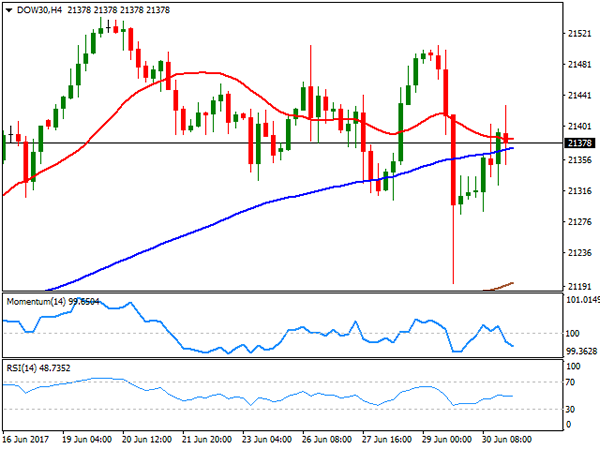
FTSE100
The FTSE 100 fell 37 points or 0.51% on Friday, to close at 7,321.72, with UK shares undermined by a resurgent Pound. Across the region, a setback in utilities and banks’ shared weighed on investors’ mood, and within the Footsie, United Utilities was the worst performer, down 3.45% after Credit Suisse cut its rating on the stock to "underperform" from "outperform." Royal Bank of Scotland was 2.25%. Mondi was the best performer, up 1.61%, followed by Smurfit Kappa that added 1.53%. From a technical point of view, the daily chart shows that the index settled below its 100 DMA, while the 20 DMA keeps gaining downward traction above it. Technical indicators in the same chart extended their slides, maintaining their bearish slopes near oversold territory. In the 4 hours chart, the technical picture is also bearish, with the benchmark developing below all of its moving averages, and technical indicators consolidating within negative territory, unable to bounce from near oversold levels.
Support levels: 7,294 7,256 7,210
Resistance levels: 7,336 7,361 7,402
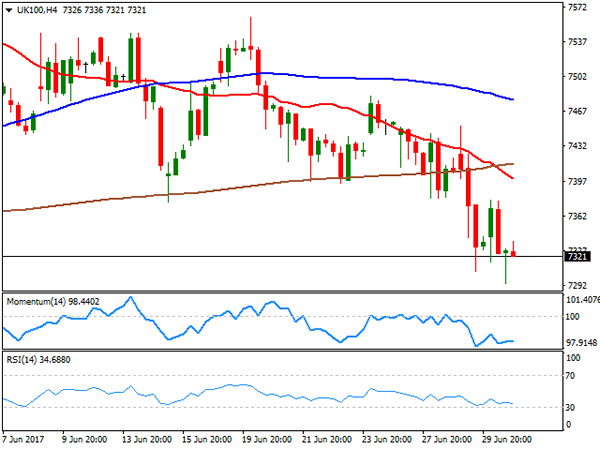
DAX
European equities closed in the red for a fourth consecutive day on Friday, with the German DAX down 90 points or 0.73%, to 12,325.10. Easing banks and chemical stocks offset a recovery in technology equities, with Bayer being the worst performer in Germany, down 3.69% after warning profit is under pressure. Deutsche Bank followed, with a 1.39% decline, while Adidas led advancers with a 2.67% gain. A stronger EUR weighed on local equities, reducing possible overseas revenues for local companies. The index settled at its lowest in two months, with the technical outlook increasingly bearish, as in the daily chart, it stands barely above its 100 DMA, currently at 12,310, while technical indicators pared losses, but are unable to bounce, remaining near oversold readings. In the 4 hours chart, the 20 SMA heads sharply lower after breaking below the 100 and 200 SMAs, all far above the current level, while technical indicators consolidate near oversold territory.
Support levels: 12,310 12,249 12,184
Resistance levels: 12,443 12,490 12,542
